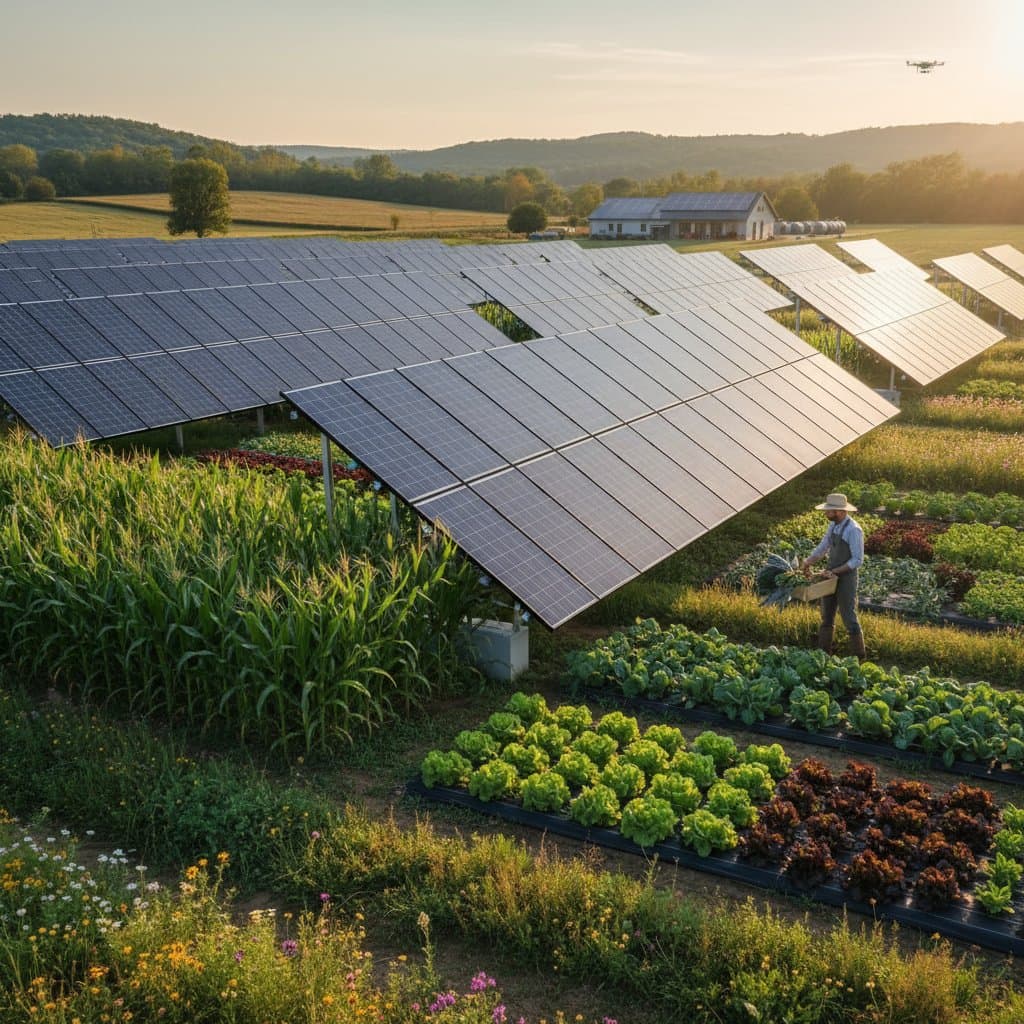The Rise of Agrivoltaics: Combining Solar Energy and Agriculture in 2025
Agrivoltaics reshapes the intersection of farmland and renewable energy. This innovative approach positions solar panels alongside crops or grazing areas, fostering simultaneous production of food and electricity. For property owners near Philadelphia, agrivoltaics offers a viable path to sustainability that preserves agricultural productivity.
Core Principles of Dual-Use Solar Farming
Dual-use solar farming, known as agrivoltaics, elevates photovoltaic panels over or amid crop rows. These installations produce power while keeping the underlying soil active for planting. Such setups minimize competition for land and enhance energy security in rural settings.
Key design elements include elevating panels to at least seven feet for machinery access, spacing them to permit sunlight penetration, and angling them to optimize both energy capture and plant growth. Shade-tolerant options like lettuce, strawberries, and pasture grasses perform well under these conditions. Livestock, such as sheep, gain from the shaded environment, which cools the ground and provides natural cover.
Essential Safety Protocols for Installation
Solar projects require rigorous compliance with electrical standards, and agrivoltaic configurations introduce additional challenges due to overlapping farm operations. Property owners must engage licensed professionals for all wiring and mounting tasks to avoid hazards.
Follow these steps:
- Select components certified for outdoor farm environments, including UV-resistant cables and IP-rated enclosures.
- Install grounded steel supports with anti-corrosion coatings suitable for moist soils.
- Ensure at least three feet of clearance between panels, drip irrigation, and pathways for equipment.
- Adhere to the National Electrical Code, obtaining permits from local authorities before starting work.
Monitor for issues like erratic voltage during pump operation or frequent breaker trips, which indicate potential grounding problems or inadequate wiring. Shut off power immediately and consult an expert in such cases.
Financial and Ecological Advantages
Agrivoltaic setups diversify income streams by pairing harvest sales with electricity generation or leasing fees. Studies from land-grant universities demonstrate that partial shading cuts evapotranspiration by up to 30 percent, maintaining crop vigor in hot climates. In Pennsylvania's variable weather, this often translates to 10-20 percent yield improvements for certain vegetables.
The systems promote ecological health by creating habitats for pollinators. Plant wildflowers and native perennials in panel interrows to draw bees, enhancing pollination for adjacent fields. Reduced evaporation also conserves water, potentially lowering irrigation needs by 20 percent or more.
Contributions to Grid Stability and Local Communities
Utilities value agrivoltaics for its role in decentralized power supply. Farms with on-site solar reduce strain on long-distance lines, stabilizing voltage and cutting losses. Pairing panels with batteries enables farms to export surplus energy during evening peaks, supporting grid balance.
Community solar initiatives on agricultural land let urban subscribers access renewables without personal installations. These programs sustain farming operations while broadening clean energy participation across Philadelphia's diverse neighborhoods.
Key Design and Upkeep Strategies
Effective agrivoltaics demands precise planning and ongoing care. Position supports to avoid interfering with plowing or harvesting, using geotechnical surveys to match foundations to soil type. Opt for galvanized steel or aluminum posts rated for wind loads common in the region.
Incorporate these maintenance practices:
- Wipe panels monthly with soft brushes and deionized water to clear debris.
- Examine connections quarterly for signs of wear, tightening bolts to manufacturer specifications.
- Test inverters bi-annually for output efficiency, addressing any drops below 95 percent.
- Scan enclosures for water ingress or overheating, powering down affected sections promptly.
Navigating Regulations and Permits in Pennsylvania
Farmland solar projects in Pennsylvania undergo zoning evaluations and environmental reviews. Local boards often mandate erosion controls and crop viability reports prior to approval. State rebates and federal grants increasingly favor dual-use designs through programs like the Renewable Energy for America Program.
Engage an electrical engineer and county extension specialist early. They assess factors such as shadow impacts on photosynthesis or altered runoff patterns, ensuring designs align with best agricultural practices.
Practical Steps for Implementation
Start with a site assessment to evaluate solar potential, soil quality, and grid connectivity. Use tools like irradiance maps and percolation tests to confirm viability. Assemble a team including solar installers, agronomists, and financiers to develop a phased rollout plan.
Post-installation, schedule annual audits by qualified technicians to verify safety and performance. Maintain vegetation buffers and monitor crop responses, adjusting panel heights if needed for optimal results.
Agrivoltaics empowers Pennsylvania farmers to harmonize energy innovation with traditional agriculture, yielding resilient operations that benefit land, economy, and environment.
